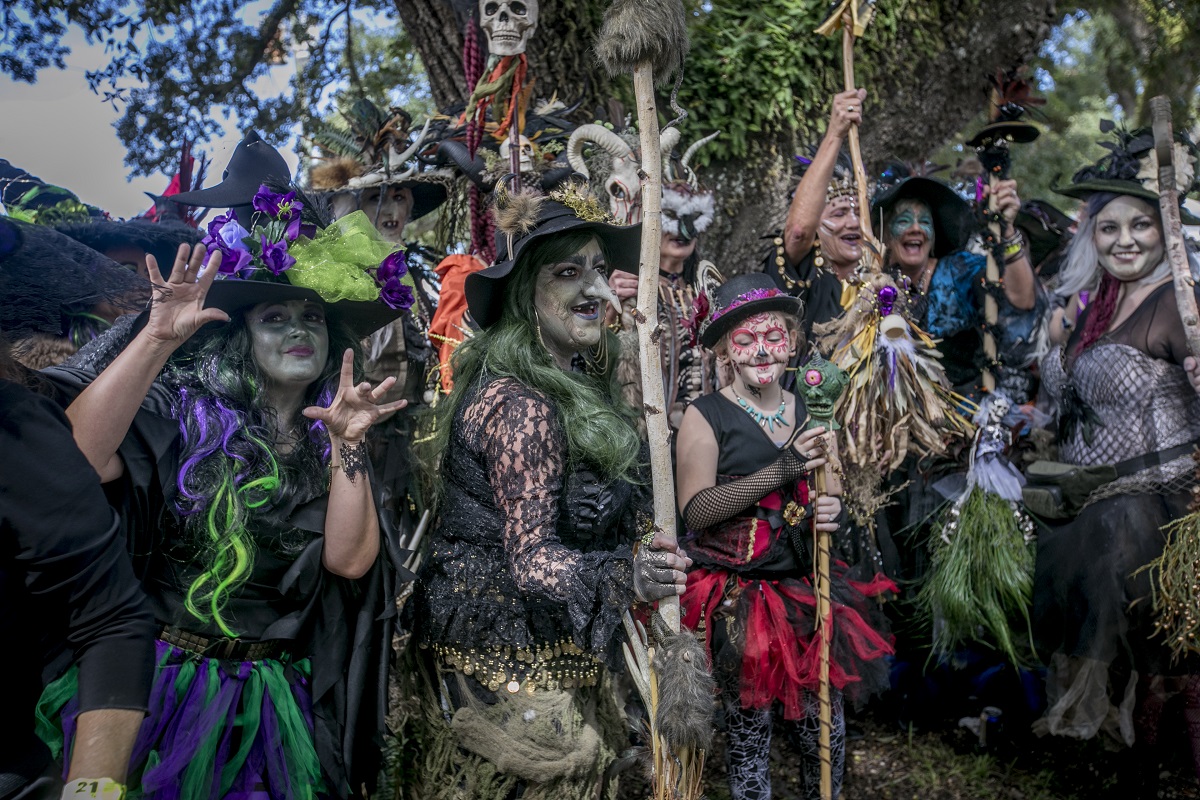Why Not Boogie with the Boogie Man?
Rougarou Fest saves the Cajun werewolf and other traditions
Published: August 31, 2021
Last Updated: December 1, 2021

Photo by Misty McElroy
Swamp witches prowl freely through the streets of Houma during the 2018 Rougarou Fest.
“It’s almost always along the same watershed,” said Jonathan Foret, executive director of the South Louisiana Wetlands Discovery Center (SLWDC). Foret’s own family has moved along Little Caillou while other groups have hopped from Dulac to Ashland to Grand Caillou. “There’s not a lot of crossover from bayou to bayou.”
Traditions are tethered to the waterways too. At Christmas, Santa trades his sleigh for a shrimp boat in a Bayou Terrebonne parade. Priests bless a decorated fleet each spring on Little Caillou. In summer, blackberries bejewel the bushes along the banks, before they’re picked and preserved for cool-weather dumplings. And in autumn, the Cajun werewolf slinks out of his swampy refuge to scare your children into behaving. (If they finish their broccoli, he’ll slink back.) “There was a specific place I thought he lived just off I-10,” said Jolie Johnson, a museum consultant in the Lafayette area and a native of Raceland, in neighboring Lafourche Parish.
Called the loup-garou in France, in Louisiana he’s the rougarou (“roo-GA-roo” in Foret’s telling) and he’s less of a disciplinary tool for Cajun mothers today. Instead he’s the poster-monster for the SLWDC’s annual fundraiser.
Since formalizing as a non-profit in 2003, the SLWDC has worked toward a $9 million campus, sited smartly between the Terrebonne Parish Library, the Houma-Terrebonne Civic Center, and the Marriott. Plans include an amphitheater, boardwalks, indoor and outdoor exhibitions, and a laboratory. A decade into fundraising, the SLWDC realized they could start serving their mission of hands-on environmental education in a more mobile way. Coastal Classrooms and Project Resilience bring lessons on land loss directly into schools, while initiatives like the Bayou Culture Collaborative and the Good Earth Market support local artists, artisans, and farmers.
But the Rougarou Fest is the biggest shebang of all. The two-day, family-friendly event draws tens of thousands of visitors from around the world. Money is raised for warnings and wisdom about climate change, but gallons of seafood gumbo are eaten too. Volunteers include a crowd of 250 to 300 regulars who serve up family recipes, throw on zombie garb for a “Thriller” performance, and tell stories like that of the rougarou, whose ferocity really rises out of fear that his home is disappearing.
“We certainly had to get creative for the 2020 festival,” said Foret. Plate lunches of festival-favorite dishes were available in a month-long drive-through. In a bit of video magic, the women of Krewe-Ga-Rou transformed into their witchy alter egos—a charming substitute for their popular parade dance. And “Terrebonne’s Top 10 Haunted Yards” predated the house floats of New Orleans, with locals crafting housefront installations from blacklights, cobwebs, and hand-painted wood cutouts. “One of course had the rougarou with little children mannequins running away. That probably didn’t help with our narrative.”
This October 22–24, the festival will move from its traditional location in downtown Houma to the campus of the Wetlands Discovery Center, where phase 1 broke ground in January and will include an outdoor wetlands exhibit—prime territory for a rougarou sighting. The adjacent Houma-Terrebonne Civic Center opens the event up to carnival rides and carnival games as well as RV parking and an anticipated RV decorating contest. Accordingly, the event will sprawl over four days instead of two.
The annual festival brings the dream of the Wetlands Discovery Center closer but Foret appreciates the activities as much as the money. To him, Rougarou Fest is a “trunk of traditions,” a waterproof place in which folklore and folkways will outlive the land on which they originated.
“If we have to move away, we put all the things in there that make us who we are—gumbo, music, how we catch seafood, our trawls.”
And the rougarou, promising not to bite, will keep his place in Cajun lives too. “Kids haven’t heard of the rougarou,” said Foret. “We’re keeping our oral traditions alive. Now we have kids doing social studies projects not only on the Rougarou Fest but the rougarou. I end up with three or four dioramas a year. I have shoeboxes of rougarous all around my office.”
For more info, visit rougaroufest.org.
Lucie Monk Carter skulks around the bayou begging children to behave.
 This article was made possible by the BHP-funded project, Coastal Impacts: An Integrated Approach for Community Adaptation, Understanding, and Planning, which will assist local communities to build intergenerational coastal literacy through community conversations around books, film, and exhibitions, fostering greater understanding of and support for coastal restoration projects.
This article was made possible by the BHP-funded project, Coastal Impacts: An Integrated Approach for Community Adaptation, Understanding, and Planning, which will assist local communities to build intergenerational coastal literacy through community conversations around books, film, and exhibitions, fostering greater understanding of and support for coastal restoration projects.
